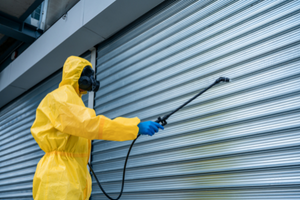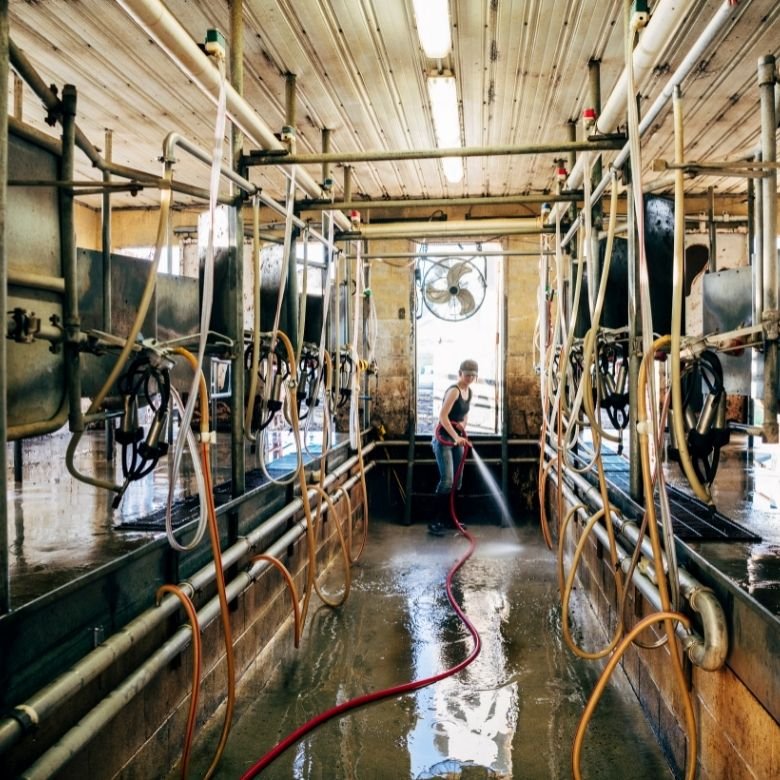Chemicals are extremely important in livestock farming. Animal housing requires products that can clean even the dirtiest surfaces. At the same time, they must not compromise animal health.

What to consider before and during disinfection?
The disinfection process in livestock farming is much more complex than it may seem. Before applying a disinfectant, the room should be properly cleaned. Otherwise, organic matter that remains on surfaces can significantly reduce the effectiveness of disinfectants. Another issue is that the intervals between cleaning cycles should not be too long, as this leads to clumping of dirt, which is then difficult to remove.
What else is important when choosing the right disinfectant for livestock housing? Be sure to pay attention to its specific purpose. A different agent will be used where the purpose is to control viruses, and another to get rid of other pathogens. Choosing the wrong product significantly reduces the effectiveness of disinfection.
Proper dosing of formulations is the next aspect to remember. Both too high and too low a concentration of the agent used can lead to undesirable consequences. Too little disinfectant leads to resistance of microorganisms to the substance and eliminates the weakest organisms, leading to domination of one microbial species. On the other hand, using too much disinfectant will not increase the effectiveness of the disinfection process. Instead, it can damage the surfaces it comes into contact with and even affect the health of animals.
And what temperature should the disinfected room be? Is it better when it’s cooler or the opposite? Again, it is helpful to know the answer to this question before disinfecting livestock housing. Typically, cold temperatures slow down the effect of disinfectants. As a result, more time is needed for the disinfection process.

Solutions proposed by the PCC Group
Products of the highest quality are needed to ensure effective indoor cleaning and eliminate all pathogenic microorganisms. The PCC Group offers products for livestock farming.
Sodium hydroxide – a substance with a wide range of applications
Because of its properties, sodium hydroxide has become a popular chemical for disinfecting livestock facilities. The agricultural sector uses this chemical compound both in solid form (caustic soda) and in solution (soda lye). It is a highly corrosive substance that can bring dairy transport and storage tanks, installations and various other apparatuses up to sterile cleanliness. The PCC Group offers soda lye in the form of solutions with different concentrations, tailored to individual customer needs. What’s more, thanks to its very high quality and purity, this product is certified by PZH (Polish National Institute of Hygiene).
Chlorine – an amber liquid with strong oxidising properties
Chlorine is yet another effective product used for disinfection. It’s available in liquid form and has an amber colour and an intense, suffocating odour. As a highly reactive substance with oxidising properties, it’s one of the most popular raw materials used in the chemical, pharmaceutical and paper industries. Chlorine is also used on a large scale in the production of PVC, paints and varnishes, hand and surface disinfectants, or bleaching and germicidal agents.
Hydrochloric acid – one of the most important acids in industry
Hydrochloric acid also ranks high as a raw material for disinfectants. It is an aqueous solution of hydrogen chloride gas, often described as one of the strongest inorganic acids. Technical grade hydrochloric acid can be used in industries that are less demanding in terms of quality, such as the production of agrochemicals, the regeneration of ion exchangers in the power industry or the regulation of water pH in industrial water treatment processes.
Green thinking
In the PCC Group portfolio, chlorine is available as one of the products in the Greenline® range. Soda lye and caustic soda can also be found in the segment focused on green chemistry. This means that the energy used in their production process comes from renewable energy sources. In addition, Greenline® products are produced using the world’s most advanced technology – membrane electrolysis. It is an energy-efficient method of producing chlorine and alkali that reduces carbon dioxide emissions into the atmosphere. For this reason, Greenline® products are widely used by manufacturers who are striving to reduce their carbon footprint and meet sustainability goals.
